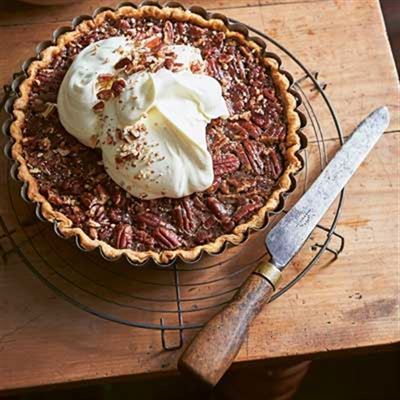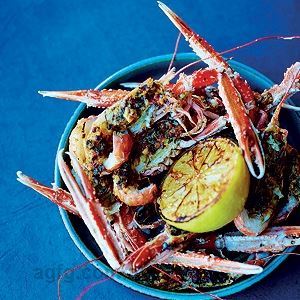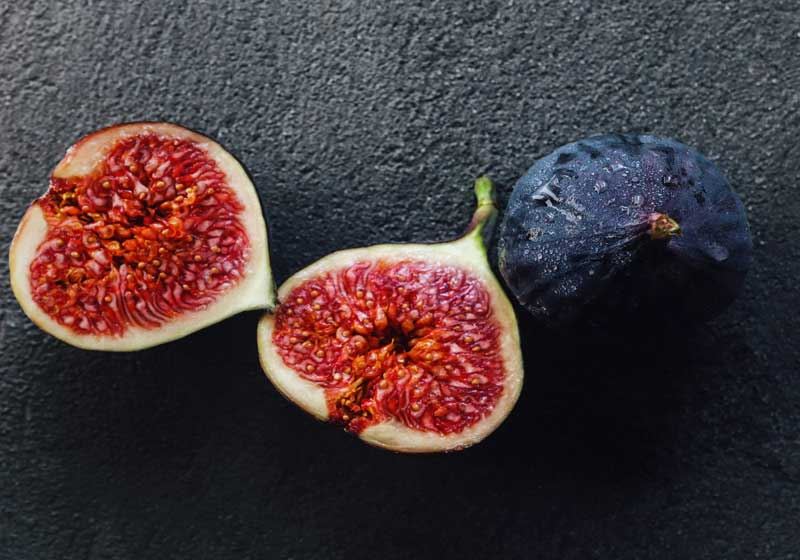Chocolate Rum Maple Pecan Pie - Recipe by Natalie Paull

Ingredients
Buckwheat crust:
225 g plain (all-purpose) flour
135 g buckwheat flour
2 g fine sea salt
225 g unsalted butter, cold and sliced into small tiles
110mL iced water
20 g egg yolk (from approx 1 egg)
Filling:
180 g whole pecans
280mL pure maple syrup
160 g demerara sugar
150 g egg (approx 3 eggs)
20 g egg yolk (from approx 1 egg, reserving the egg white to seal the tart shell)
100 g unsalted butter, super soft
60mL (cream (35% milkfat)
20mL dark rum (or extra maple syrup for booze-free)
15 g Dutch (unsweetened) cocoa powder
5 g vanilla paste
4 g sea salt flakes
To finish:
200mL thick cream (45% milkfat)
10mL dark rum (optional)
3 g vanilla paste
Pinch of sea salt flakes
Method
For the pastry, put the flours and salt in a wide mixing bowl. Using your fingertips, rub the butter into the dry ingredients just until the butter lumps are the size of whole almonds and the surrounding flour feels like silky almond meal with buttery lumps throughout.
These large butter lumps are going to melt during baking, creating steam, which will flake the pastry apart unbelievably!
Combine the iced water and egg yolk together and then add to the buttery flour. Keep mixing with your hands, lightly squeezing the dough together, until it looks like crumbly/shaggy playdough. Wrap the dough lightly in plastic, then flatten, by squeezing, into a 2 cm thick round disc with smooth sides.
Chill this dough for a minimum of 1 hour or up to 2 days – just ensure that the pastry is nicely pliable before rolling.
For a 23 cm tart or pie dish, roll out half the dough to 35 cm circle, about 3–4 mm thick. Trim to a smooth-edged 32 cm circle, then gently lift and flop the dough into the tin.
Trim cracked edges before lifting the circle. The movement can exacerbate the cracks.
Working in sections, tuck the dough right into the corner and against the side of the tart tin to prevent air pockets, then use your fingers or rolling pin to push/trim the excess dough off the top. Freeze for at least 1 hour before blind baking.
Hold a little of the excess dough to patch any cracks after blind baking. With the remaining offcuts, stack and press together. They can be re-rolled twice.
To blind bake, preheat the oven to 200cC (390°F). Cover the frozen dough with a piece of aluminium foil (dull side down), tucking it snugly into the corner of the tin. Fill the lined tin with approximately 750 g caster (superfine) sugar. Place in the oven, then reduce the heat to 165 C and bake for 50–60 minutes. Remove the foil and bake for another 5–10 minutes so the base crust is a biscuity brown colour.
For the filling, heat your oven to 130 C and scatter the pecans onto a shallow baking tray. Bake for 25–30 minutes until they’re just starting to darken on the outside and are the palest brown inside – cut or snap one open to assess. Set 20 g aside for the end decoration and use the rest for the filling. Keep the oven on 130 C and set a rack on a low shelf and remove the upper racks.
Set up a double boiler: heat 5 cm deep water in a 20 cm saucepan to a low simmer and choose a heatproof bowl large enough that the base won’t touch the water when resting on top of the saucepan.
Weigh all the remaining ingredients, except the pecans, into the bowl and whisk together thoroughly. The butter and cocoa will be lumpy but all will melt and combine together as it heats.
Set the bowl over the double boiler and whisk occasionally until the mix thickens and the chocolate and butter melt. This should take around 10 minutes. The mix will read 55–60 C on a digital thermometer and will look like a lustrous brown milkshake. Take care it doesn’t overcook and get chunky/curdled at any stage. Scrape the filling into a jug.
If the mix does start cooking firm at the edge, act fast. Take the bowl off the double boiler and whisk vigorously to release the steam and regulate the temperature. If the mix gets very overcooked, strain out the cooked egg chunks and whisk the dr ained filling into a fresh whole egg.
Place the blind-baked crust, still in the tin, on a shallow baking tray. If there are any large cracks or dipped sides, soften some leftover dough and gently patch any large fissures – taking care not to press hard and break the crust. Meticulously brush a light layer of the egg white on the inside of the tart to seal any fine cracks, then bake for 3 minutes to seal the egg white.
Bring the tart crust back out and crush the toasted pecans with force in your hands while letting them fall onto the base of the crust.
Par-crushed pecans give the top a nougatty texture and make cutting the tart easier than whole pecans.
Return the crust to the oven. Keeping your eye on where the crust edge is lowest, carefully pour the filling into the crust, being careful not to overfill. Tease the pecans back up to float on the surface with your finger or a spoon, ensuring there are no pecan-less gaps on the top.
Bake for 50–60 minutes. The wobble check is different for this pie because of the crusty nut raft: touch the top of the pie to feel how cooked it is below. If liquid and jiggly, bake longer. Gently peel off a pecan from the centre to check underneath – it will look like a stable yet soft cream. There should be gooey residue on an inserted skewer (85 C internal).
Cool at room temperature for a least an hour (2 is good) or chill for a chewier bite.
To finish, whip the cream with the rum, vanilla and salt and pile onto the centre of the cooled pie. With an offset spatula, gently spread the cream over the pie, leaving a 6 cm border all around so you can see the pie goodness underneath. Hold a handful of the reserved toasted pecans in your fist and crush them as you let them fall onto the cream ( just like the filling).
To serve, cut gently through the cream, pecan top and side crust with a fine serrated knife, clean the knife, then cut through fully along the slice line to chomp through to the base.

Photo Credits: Photographer: © Rochelle Eagle 2024








